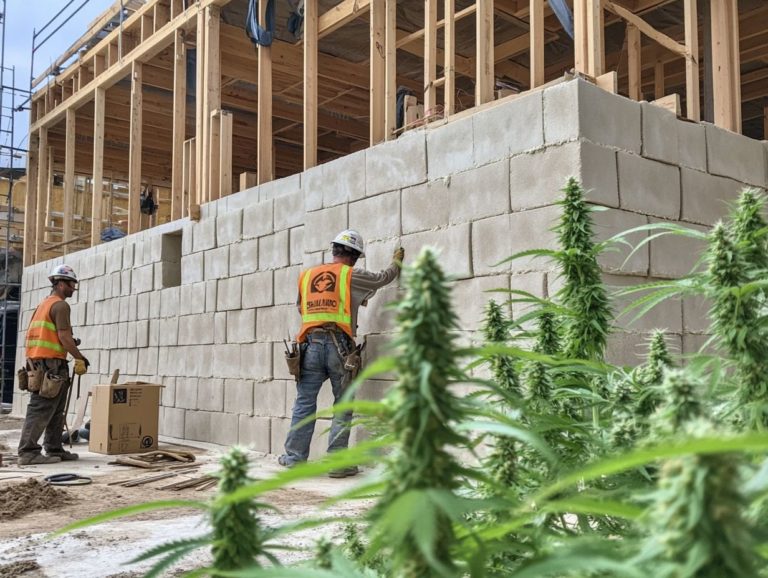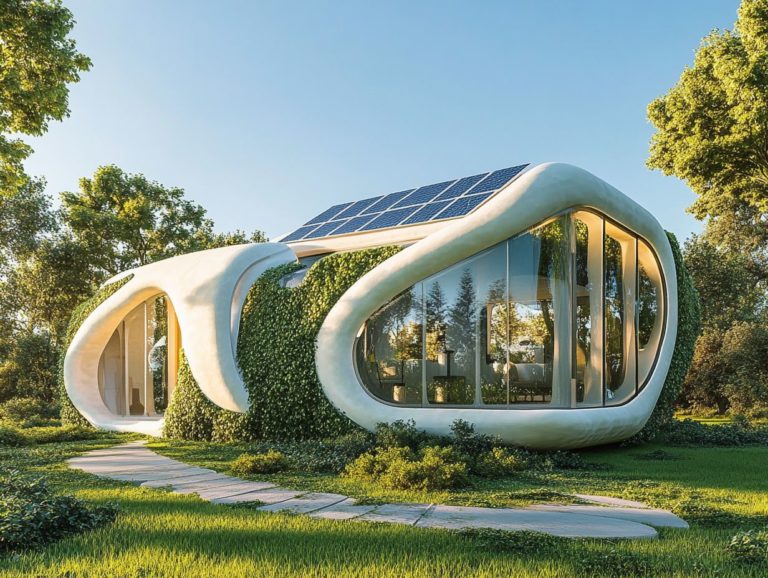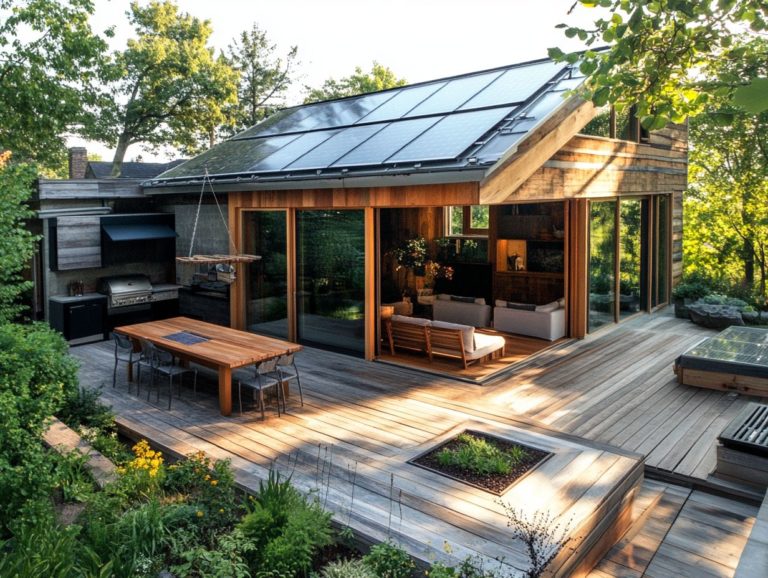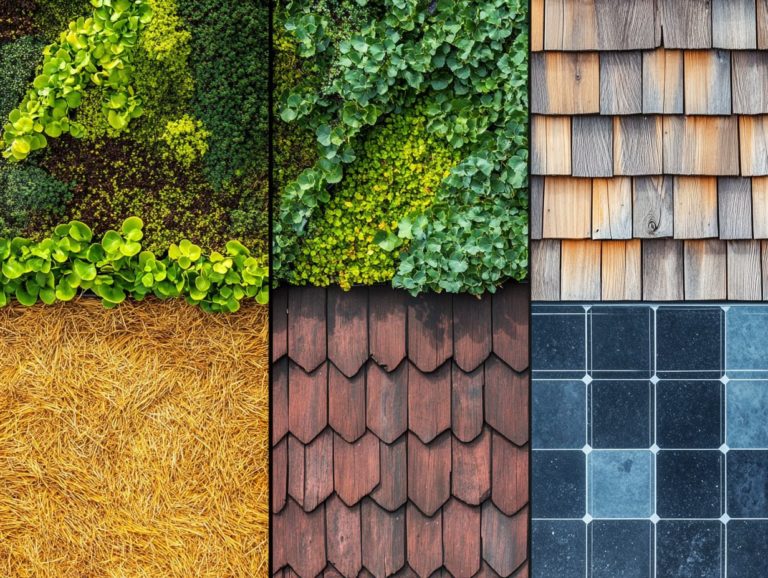10 Tips for Sustainable Home Renovation
As a homeowner, you are likely seeking eco-friendly options for your renovations as the world increasingly emphasizes sustainability.
This article offers ten practical tips for sustainable home renovation. It will guide you through choices like selecting energy-efficient appliances, using sustainable materials, and incorporating renewable energy sources.
By focusing on environmental benefits and long-term savings, these strategies enhance your living space and foster a positive impact on the planet.
Explore how thoughtful renovations can pave the way for a greener home and a brighter future.
Contents
- Key Takeaways:
- 1. Choose Sustainable Materials
- 2. Consider Energy-Efficient Appliances
- 3. Use Low or Zero VOC Paints
- 4. Opt for Natural Lighting
- 5. Invest in Insulation
- 6. Incorporate Renewable Energy Sources
- 7. Reuse and Recycle Materials
- 8. Opt for Water-Efficient Fixtures
- 9. Consider the Lifecycle of Materials
- 10. Work with Sustainable Contractors
- What Is Sustainable Home Renovation and Why Is It Important?
- How Can Sustainable Home Renovation Save Money in the Long Run?
- What Are the Environmental Benefits of Sustainable Home Renovation?
- What Are Some Common Mistakes to Avoid When Renovating for Sustainability?
- How Can Homeowners Incorporate Sustainable Practices in Their Daily Lives?
- What Are the Future Trends in Sustainable Home Renovation?
- Frequently Asked Questions
- What are the benefits of implementing sustainable practices in home renovation?
- How can I incorporate sustainable materials in my home renovation?
- What are some ways to save energy during a home renovation?
- Are there any tips for reducing water usage during a home renovation?
- How can I ensure my home renovation is environmentally friendly?
- Are there any tax incentives for implementing sustainable practices in home renovation?
Key Takeaways:
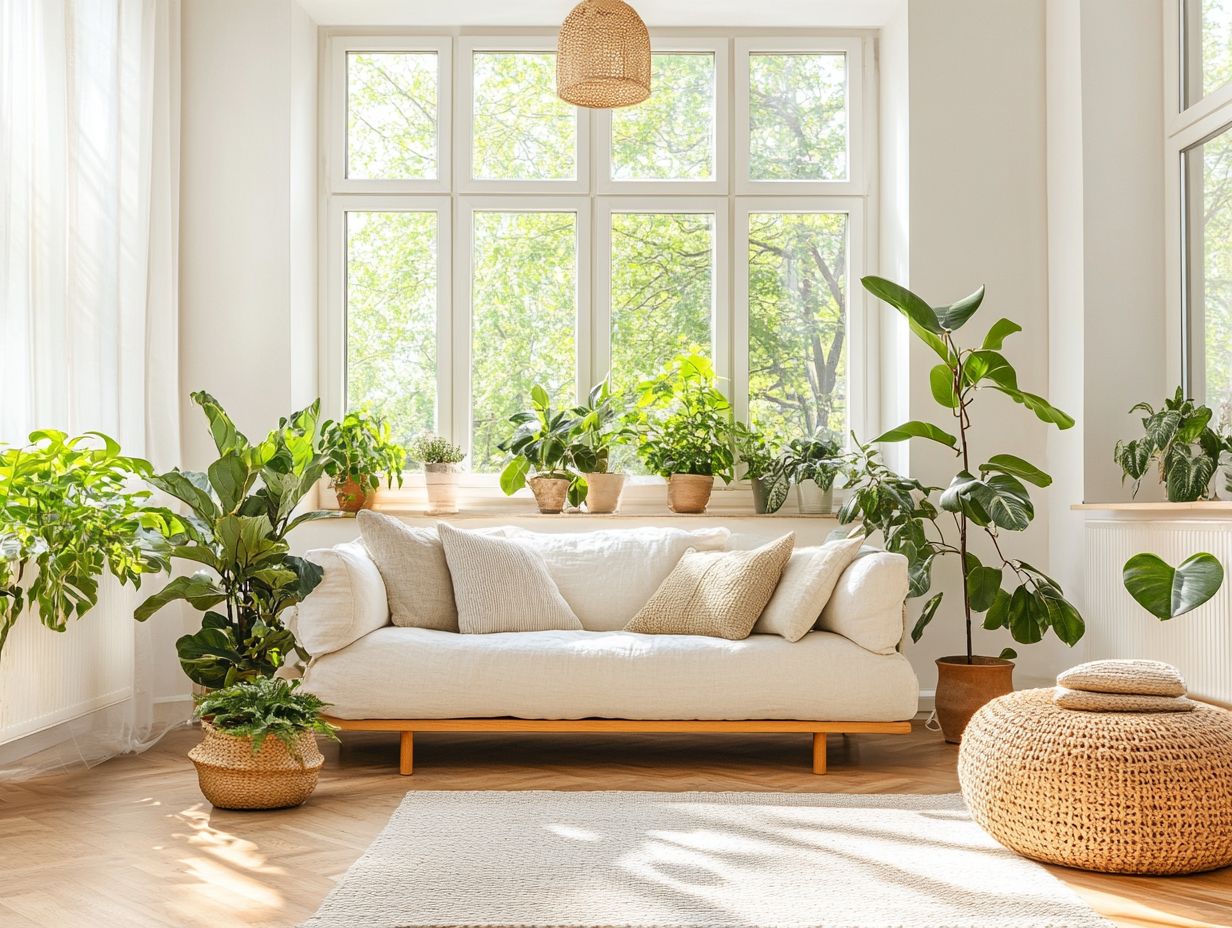
Choose sustainable materials to reduce your carbon footprint and create healthier living spaces.
Use energy-efficient appliances to save money on utility bills and reduce energy consumption and greenhouse gas emissions.
Incorporate renewable energy sources, such as solar panels, to decrease reliance on fossil fuels and lower long-term energy costs.
1. Choose Sustainable Materials
Choosing sustainable materials is crucial for eco-friendly renovations. It enhances your home’s beauty while lowering your carbon footprint, and you can explore 10 ways to make your home more sustainable for additional ideas.
By opting for materials like hardwood products, reclaimed furniture, and wood certified for sustainable forestry practices, you contribute to waste reduction and minimize greenhouse gas emissions.
Exploring locally sourced options supports regional economies and cuts down on transportation emissions. This makes them an environmentally conscious choice.
Using low VOC paints can greatly improve indoor air quality. This ensures a healthier living space for you and your family.
Researching suppliers is essential. Partnering with certified products ensures that the materials meet rigorous environmental standards.
Your choice for sustainable materials not only looks great but also makes a real difference! It conserves resources and promotes biodiversity, paving the way for a greener tomorrow.
2. Consider Energy-Efficient Appliances
Incorporating energy-efficient appliances is crucial for reducing your home’s energy consumption. This choice lowers your carbon footprint and provides long-term savings on energy bills.
These appliances, often sporting the Energy Star certification, include refrigerators, washing machines, and dishwashers, all designed to use significantly less energy than traditional models.
By swapping out older models for these eco-friendly options, you support sustainable practices and enjoy modern conveniences.
The installation process typically involves hiring a professional, although some may prefer to take on simpler setups themselves.
While you might encounter higher upfront costs when purchasing Energy Star appliances, the long-term savings on utility bills can quickly make up for that initial investment. This proves them to be a savvy economic choice.
3. Use Low or Zero VOC Paints
Using low or zero VOC (volatile organic compounds) paints is crucial for creating a healthier indoor environment. These paints minimize the environmental footprint of your renovation projects.
They significantly improve air quality by reducing harmful emissions that can worsen allergies and respiratory issues.
By choosing lower VOC levels, you also contribute to cutting down greenhouse gas emissions, making this a more sustainable choice overall.
In today s market, you’ll find a wide variety of low VOC options available, from vibrant colors to subtle pastels. This ensures you can discover the perfect hue for your space without compromising your health or principles.
When selecting shades, consider how they interact with natural light and your existing d cor. Aim for a palette that enhances the overall ambiance while keeping eco-friendliness at the forefront of your design choices.
Start your journey towards a green home today!
4. Opt for Natural Lighting
Maximizing natural light in your home through thoughtful design and strategic skylight installations can significantly reduce your need for artificial lighting. This change not only enhances the ambiance but also plays a vital role in saving energy.
By choosing eco-friendly windows designed to minimize heat loss while maximizing sunlight, you can boost your living spaces’ efficiency even further. Smart architectural choices, such as open floor plans and the careful placement of mirrors, allow light to reflect and spread throughout various rooms, creating a brighter and more welcoming environment.
These modifications also enhance your home’s aesthetic appeal and lead to significant energy savings. Reduced energy consumption means lower utility bills, making it a smart, eco-friendly choice that benefits both you and the planet.
5. Invest in Insulation
Investing in quality insulation materials is essential for improving heating efficiency and maintaining a comfortable indoor climate while promoting sustainable renovations.
You have various options, including fiberglass, foam board, and cellulose, each offering unique thermal performance and tailored to different needs.
- Fiberglass is popular for being affordable and fire-resistant.
- Foam board is great at keeping your home warm.
- Cellulose, made from recycled materials, is an eco-friendly choice with solid thermal performance and excellent sound-dampening qualities.
By selecting effective insulation solutions, you can lower your energy costs and enjoy a long-term return on investment through reduced heating bills and increased property value.
6. Incorporate Renewable Energy Sources

Incorporating renewable energy sources, like solar panels, into your home can cut your energy bills and reduce your carbon footprint while embracing sustainable building practices.
As a homeowner, you have many options to harness renewable energy effectively. Beyond solar panels, consider wind turbines and geothermal systems as viable alternatives. Wind energy can be especially beneficial in areas with consistent breezes, while geothermal systems use the earth’s stable temperatures to manage your indoor climate efficiently.
Before committing to these technologies, conduct a thorough energy audit. This assessment will reveal your energy usage patterns and help you identify the best solutions tailored to your needs, ensuring your investments in renewable energy are both wise and impactful.
7. Reuse and Recycle Materials
Focusing on the reuse and recycling of materials in your remodeling plans can greatly reduce waste and promote a sustainable renovation process, aligning perfectly with eco-friendly practices.
Consider using reclaimed wood for cabinetry or flooring; it adds character while reducing the demand for new timber.
Salvaging fixtures from older buildings not only provides unique aesthetic elements but also diverts waste from landfills.
Local salvage yards or online marketplaces can be treasure troves, offering everything from vintage hardware to antique lighting.
By utilizing these materials, you support local economies and spark creativity in your design process.
Ultimately, adopting these practical methods enhances your project’s sustainability and encourages a more mindful approach to your consumer habits. Explore your options today and make a difference for both your home and the planet!
8. Opt for Water-Efficient Fixtures
Opting for water-efficient fixtures, like low-flow faucets and toilets, is an essential step in crafting a sustainable home that conserves water resources while trimming down your utility bills.
These fixtures reduce water use and improve your home’s efficiency. Technologies like dual-flush systems and aerators lower your water bills while supporting environmental efforts.
The installation process is typically quite simple and can often be tackled by a DIY enthusiast. However, enlisting a professional might ensure you get the best performance out of your fixtures.
Making eco-friendly choices enhances your home and contributes to preserving invaluable water supplies for future generations.
9. Consider the Lifecycle of Materials
Considering the lifecycle of materials in your home renovation is crucial for understanding their environmental sustainability and ensuring the long-term health of your living space.
By carefully evaluating the sourcing, manufacturing, and disposal processes of these materials, you can make informed choices that benefit both your personal wellness and the planet.
When you choose responsibly sourced materials, you’re often selecting those from renewable resources. Eco-certified products those certified to meet environmental standards significantly minimize waste in landfills and reduce harmful emissions during manufacturing.
Exploring options like bamboo flooring, recycled glass, or low-VOC paints offers a wealth of benefits that go beyond mere aesthetics. Ultimately, embracing sustainable choices is about crafting a healthier home environment while being a conscientious steward of our precious natural resources.
10. Work with Sustainable Contractors
Collaborating with sustainable contractors who prioritize eco-friendly practices is essential for your green remodeling project, ensuring alignment with sustainable building principles.
By carefully selecting professionals with a solid grasp of green building and verified green credentials, you can significantly enhance the quality and sustainability of your renovations. Examine their experience with eco-friendly materials, energy-efficient designs, and innovative solutions that minimize environmental impact.
These experts possess a wealth of knowledge that can turn your vision into reality while adhering to modern sustainability standards. Their insights can also help you navigate local regulations and certifications that legitimize your project’s environmental commitment, ultimately leading to a healthier living space.
What Is Sustainable Home Renovation and Why Is It Important?
Sustainable home renovation involves embracing eco-friendly and energy-efficient solutions that seamlessly integrate sustainable materials and designs. Implementing 10 ways to reduce waste during renovation cuts your environmental impact and makes your home better.
By adopting these practices, you actively contribute to reducing carbon emissions and creating a healthier living environment for yourself and your family.
Energy-efficient homes are pivotal in shaping a sustainable future. They significantly lower energy consumption and alleviate the strain on nonrenewable resources. Incorporating locally sourced materials and innovative designs can enhance indoor air quality and promote overall well-being.
As awareness of climate change continues to rise, it’s crucial to adopt sustainable renovation methods now. This choice empowers you to tackle environmental challenges while enjoying the perks of modern, efficient living.
How Can Sustainable Home Renovation Save Money in the Long Run?
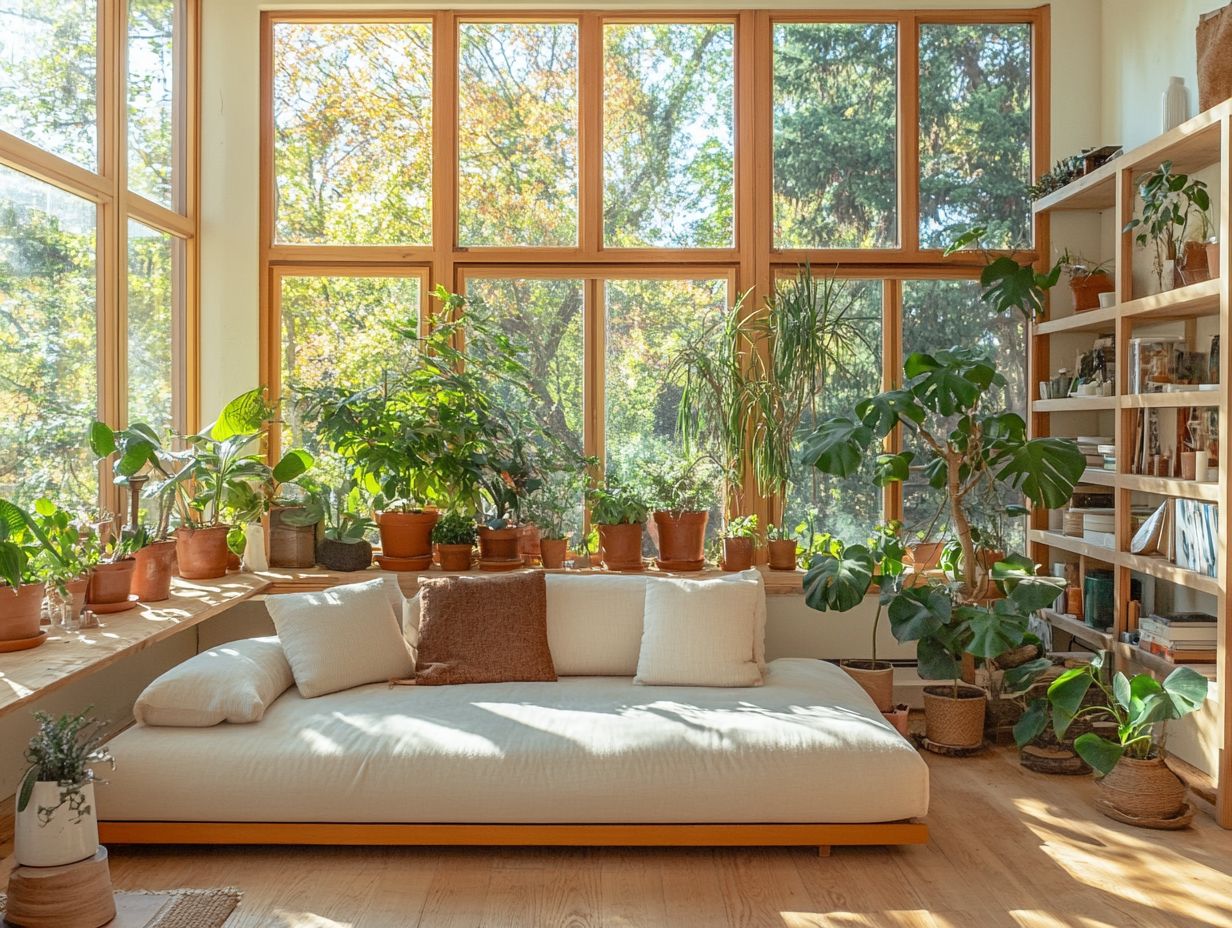
Sustainable home renovation can lead to substantial long-term savings through reduced energy bills, lower maintenance costs, and increased property value. Incorporating the 5 best sustainable practices for builders makes it a savvy investment for you as a homeowner.
For example, when you install a smart thermostat, you can optimize your heating and cooling systems to align with your daily routine. This lowers utility bills and promotes a sustainable lifestyle.
Incorporating energy-saving devices like LED lighting and high-efficiency appliances can yield impressive cost reductions over time.
Additionally, homes outfitted with these energy-efficient upgrades tend to attract buyers willing to pay a premium for lower operating costs and modern conveniences. This ultimately enhances the overall market appeal of your property.
What Are the Environmental Benefits of Sustainable Home Renovation?
The environmental benefits of sustainable home renovation are impressive. These benefits encompass reduced carbon emissions, minimized waste, and the conservation of natural resources all contributing to a healthier planet.
By using reclaimed materials, you not only divert waste from landfills but also help preserve the earth’s limited resources. Energy-efficient appliances play a critical role in lowering energy consumption, directly cutting down on greenhouse gas emissions and improving air quality.
Embracing these practices initiates a ripple effect that enhances community sustainability. As more homes implement eco-friendly renovations, neighborhoods blossom with greenery, fostering a collective responsibility towards environmental stewardship.
This cultural shift towards sustainable living has the potential to mitigate the effects of climate change, creating a meaningful impact for future generations.
What Are Some Common Mistakes to Avoid When Renovating for Sustainability?
When renovating for sustainability, you might overlook critical aspects that can thwart your eco-friendly ambitions. To avoid these pitfalls, following a comprehensive guide like creating a sustainable home: step-by-step can help prevent mistakes that ultimately compromise both energy efficiency and your overall environmental impact.
One common misstep is neglecting the importance of energy checks, which are essential for identifying existing inefficiencies in your home. Failing to install proper insulation can waste energy and increase costs over time. Additionally, considering the 5 must-consider factors for sustainable renovation can ensure that choosing materials doesn’t undermine your renovation efforts.
To sidestep these pitfalls, consider taking these steps:
- Schedule energy checks before diving into the renovation.
- Invest in high-quality insulation.
- Choose renewable or recycled materials whenever feasible.
This thoughtful approach strengthens your commitment to environmental responsibility while securing long-term savings for your household.
How Can Homeowners Incorporate Sustainable Practices in Their Daily Lives?
Ever wondered how small changes can lead to big savings? Homeowners like you can easily weave sustainable practices into your daily routine by embracing straightforward energy-saving tips, harnessing smart home technology, and making eco-conscious choices.
By opting for energy-efficient lighting options such as LED bulbs, you can significantly reduce your electricity consumption while still enjoying a bright, inviting ambiance in your home.
Installing water-saving fixtures, including low-flow showerheads and faucets, minimizes water usage without compromising comfort.
Engaging with local sustainability initiatives provides a wonderful opportunity to connect with your community. You can exchange ideas and resources geared towards further conservation efforts.
Every small action can spark a wave of change for our planet! These collective actions inspire your neighbors and friends to adopt similar practices, ultimately enhancing the overall health of our planet and paving the way for a greener future.
Start your sustainable renovation today and see the benefits for yourself!
What Are the Future Trends in Sustainable Home Renovation?
The future of sustainable home renovation focuses on eco-friendly materials, smart technology, and innovative designs. These elements enhance energy efficiency and reduce your environmental impact.
As you aim to lower your carbon footprint, consider designs that use sunlight for heating and lighting. This method decreases your need for fossil fuels.
Using energy-efficient systems, like smart thermostats, helps you manage energy consumption effectively throughout the day. These practices not only save you money but also support environmental sustainability.
By balancing modern living with ecological responsibility, you can join a community dedicated to these transformative changes.
Frequently Asked Questions
What are the benefits of implementing sustainable practices in home renovation?
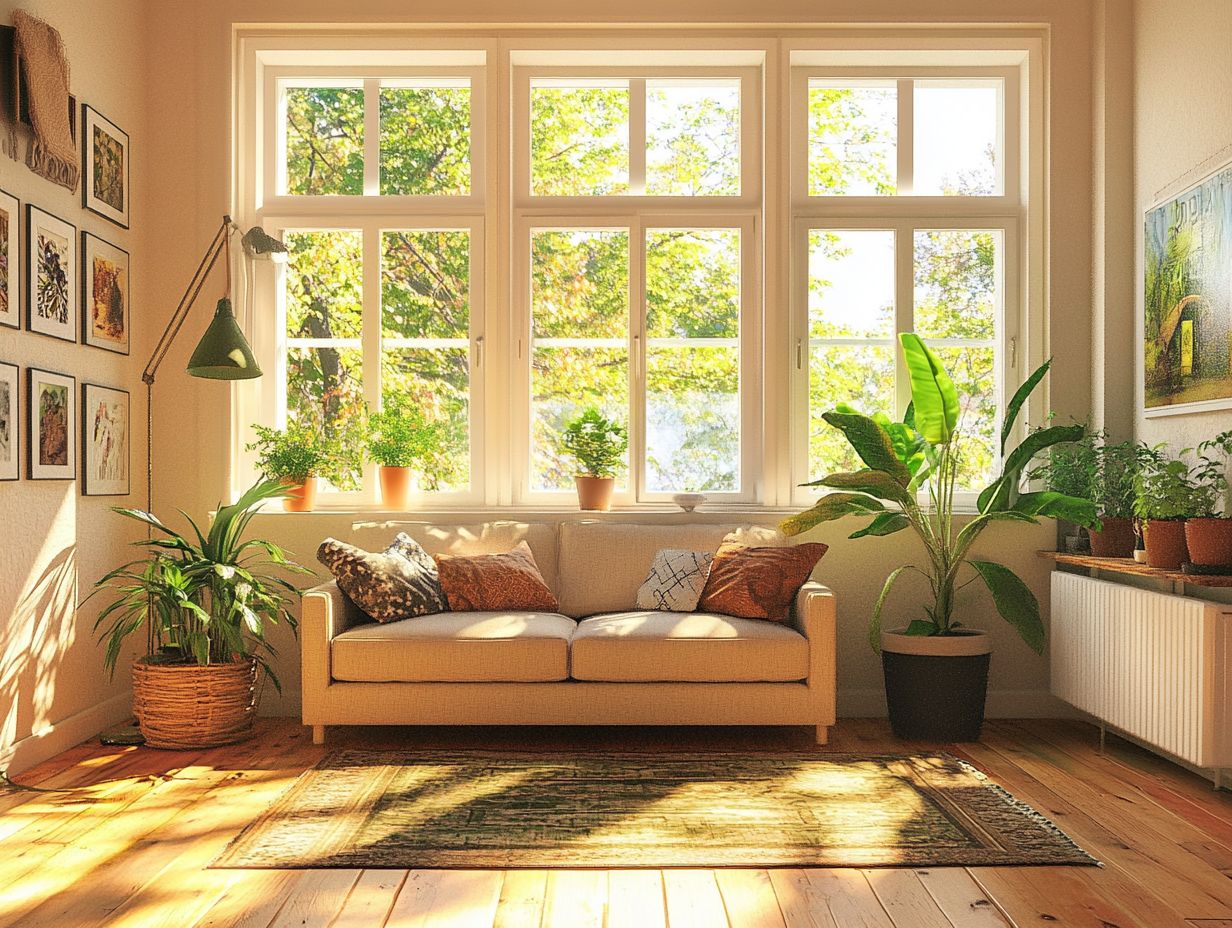
Sustainable home renovation saves money on energy and water bills. It also improves indoor air quality and boosts your home’s value, especially when you learn how to implement sustainable practices at home.
How can I incorporate sustainable materials in my home renovation?
Use eco-friendly materials like bamboo, reclaimed wood, and recycled glass. Opt for paints that release fewer harmful chemicals.
What are some ways to save energy during a home renovation?
Install energy-efficient appliances and use LED lighting. Proper insulation and renewable energy sources like solar panels are also great options.
Are there any tips for reducing water usage during a home renovation?
Install low-flow fixtures for faucets and showers. Choose drought-resistant plants for landscaping to save water.
How can I ensure my home renovation is environmentally friendly?
Work with experienced contractors in sustainable building. Research green building certifications and dispose of waste materials properly.
Are there any tax incentives for implementing sustainable practices in home renovation?
Yes, tax incentives are available for renovations that meet sustainability standards, like the Residential Renewable Energy Tax Credit for installing solar panels.


